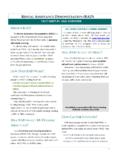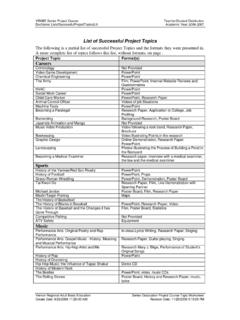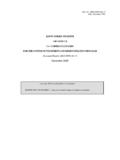Transcription of Ames Room Demonstration - Project LITE
1 ames room Demonstration Adelbert Ames, Jr. devised a number of what he called demonstrations. Each provides a dramatic visual experience. The ames room presents the viewer with what appears to be a rectangular room with parallel walls and floors when viewed monocularly from one vantage point. The version included here is one of an infinite number of possible configurations that produce the same geometrical pattern on the retina. However, when two objects of equal physical size are moved about in the room , their relative size appears to change by an implausible amount. This percept may be caused by our assumptions about the nature of the room based on prior experience or it may have one or more other causes. Even when the observer knows its true shape, the room still induces the same unnatural percept.
2 There is clearly more to the ames room than meets the eye! Construction Guide F. 1. Print the ames room on thick paper. C. 2. Cut out the two patterns along the solid lines. 3. Cut out the two cross hatched regions. B. 4. Connect the two sections by taping tab X' to the corresponding edge. B. 5. Fold the paper on the dashed lines using a ruler or other hard edge. 6. Tape the lettered tabs in alphabetical order to the outside of the D. corresponding letter edges shown in the room pattern. G. Viewing Suggestions Place the ames room under a bright light source. Look through the cut-out viewing hole opposite the windows. E. Move a long thin object like a pencil around in the room to see how its apparent size changes. Place two identical small objects at different locations in the room and compare their apparent relative sizes.
3 G. This is how the finished E. ames room appears viewed through the door viewer. Equal size chess F. A. pawns have been placed cut on solid lines in the far back corners. A. fold on dashed lines cut out C. D cut out (optional). Original References: Ames, A. An Interpretive Manual for the Demonstrations, 1955. Ittelson, W. H. The Ames Demonstrations in Perception, 1952. NOTE: To greatly improve the visibility of the room , especially for far-sighted Credits: observers, insert a standard hardware This version of the ames room was developed by K. Brecher store "door viewer" - like the one shown and R. Puno (Boston University). It extends designs here - through the viewing hole. One with by A. Ames, J. Zanker, and others. a diameter of 1/2", length ", and field of view 180 works best. Project LITE is supported by NSF Grant # DUE - 0715975.
4 C. F. G. A. X. n by ). esig iversity md n Roo on U. mes (Bost EA o LIT R. Pun ject Pro er and rech K. B. B. D. E. X.







